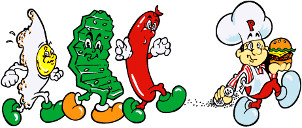(→PC: "my" to "by".) |
(As per http://gdri.smspower.org/wiki/index.php/Sakata_SAS, http://sasgames.jp/business/business.html0161128134620/http://sasgames.jp/business/business.htm and http://web.archive.org/web/20050208005617/www.sas-sakata) |
||
| Line 32: | Line 32: | ||
{{-}} | {{-}} | ||
==NES== | ==NES== | ||
Developed by | Developed by Data East and Sakata SAS, and published in Japan by Namco in 1986. It was later published by Data East themselves in American in 1987. Extremely accurate, although very fast paced and a little difficult. | ||
<gallery> | <gallery> | ||
Image:BurgerTime_NES.gif|screen | Image:BurgerTime_NES.gif|screen | ||
| Line 39: | Line 39: | ||
</gallery> | </gallery> | ||
{{-}} | {{-}} | ||
==PC== | ==PC== | ||
[[Image:BurgerTime PC.png|thumb|left|screen]] | [[Image:BurgerTime PC.png|thumb|left|screen]] | ||
Revision as of 23:01, 24 December 2018
Apple II

Developed and published by Mattel Electronics in 1983.
Atari 2600
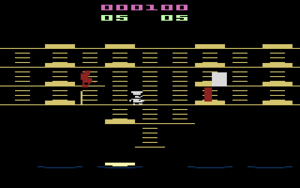
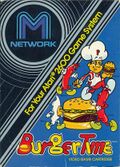
Developed and published by Mattel Electronics in 1982. Rather accurate gameplay despite very unfortunate graphics. The layers of the hamburger are indistinguishable until they land on the tray. Only the hot dog and Peter are recognizable. The remaining enemies are two growing squares and a single French-fry.
Commodore 64
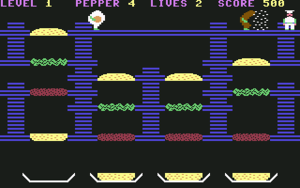

Developed and released by Interceptor software in 1984 for European countries. Also developed for the Amstrad CPC
ColecoVision
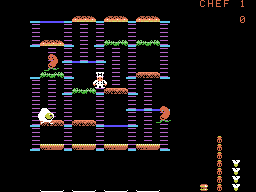
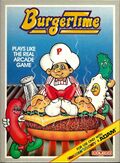
Developed by Mattel Electronics in 1984 just before they went out of business. Coleco then purchased the game from Mattel and published it themselves.
Intellivision
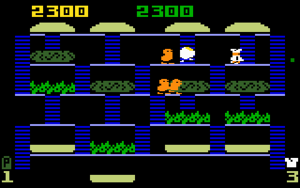

Developed and published by Mattel Electronics in 1982
MSX

Developed and published by Dempa in all countries where the MSX was successful in 1986.
NES
Developed by Data East and Sakata SAS, and published in Japan by Namco in 1986. It was later published by Data East themselves in American in 1987. Extremely accurate, although very fast paced and a little difficult.
-
screen
-
Famicom box
-
NES box
PC
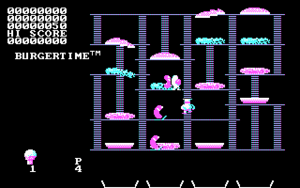
Developed and published by Mattel Electronics in 1982.
PlayStation 2
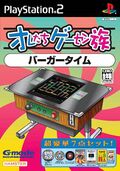
TI-99/4A
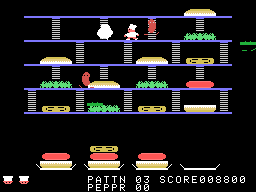
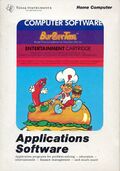
Developed and published by Texas Instruments with permission from Data East in 1984.
Noteworthy
Atari 5200 & 7800
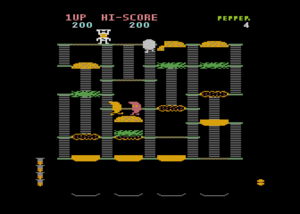
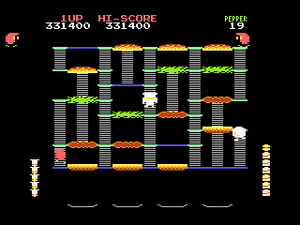
AtariAge user Ken "kenfused" Siders ported Burgertime to the Atari 5200 and Atari 7800, giving it the name Beef Drop. Burgertime was ported to many home game consoles and computer systems, but it never found a home on the Atari 5200 until now. While a disk-based version of Burgertime was released for the Atari 8-bit computers, this version has been written from scratch to be more faithful to the arcade version than the older 8-bit port. This new version of Burgertime began life as an April Fool's joke in our Atari 5200 Forum and quickly turned into a real homebrew development effort. Ken Siders is also responsible for the Atari 7800 conversion of Q*bert, named bonQ.
Commodore 64
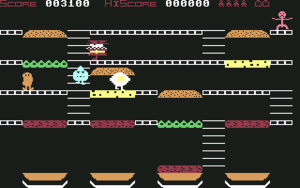
Mr. Wimpy was published in 1984 by Ocean Software for various popular computer systems in England, including the Commodore 64 and the Sinclair ZX Spectrum. It contained more than one level of gameplay, with the second level resembling BurgerTime. The first leveled involved collecting the ingredients from an open play field. The game was made as a promotion for the Mr. Wimpy hamburger franchise.
MSX
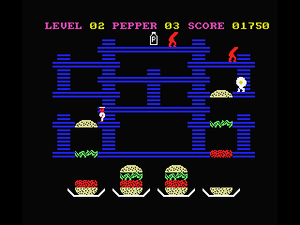
Developed and published by Aackosoft International in 1986. Sold predominantly where Dempa's official conversion wasn't widely available.
TI-99/4A

A slightly less than accurate conversion of the arcade game, developed by DataBiotics in 1983.
